14.4: North America
- Page ID
- 53038
The Southwest
Southwestern indigenous cultures have produced a variety of architectural, artisanal, and ritual art forms for centuries.
Learning Objectives
Describe the Anasazi, Hopi, Navajo, and Hohokam cultures of the American Southwest
Key Takeaways
Key Points
- The Anasazi, the ancestors of Pueblo Native American tribes, produced decorative pottery for storage purposes.
- Chaco Canyon in New Mexico (c. 10th century) is one of the most impressive early examples of Southwestern Native American architecture.
- The Navajo emigrated from Northern Canada to the Southwest sometime after 1000 CE. The sand paintings and weavings for which this culture is renowned are gender-specific. Men created sand paintings while women created weavings.
- Mastery of acid etching allowed the Hohokam culture to create lasting designs in bone, shell, and stone.
Key Terms
- Anasazi: A Native American people who once lived in cliff dwellings in Utah and Colorado.
- Pueblo: Modern and ancient communities of Native Americans in the Southwestern United States of America.
- xeriscaping: Landscaping and gardening that reduces or eliminates the need for supplemental water from irrigation.
- Navajo: Currently the largest Native American tribe in North America.
The Anasazi (1000 BCE–700 CE) are the ancestors of today’s Pueblo tribes. Their culture formed in the American southwest after the cultivation of corn was introduced from Mexico around 1200 BCE. Additionally, the Navajo and Apache emigrated from Northern Canada to the Southwest sometime after 1000 CE. People of this region developed an agrarian lifestyle, cultivating food, storage gourds, and cotton with irrigation or xeriscaping techniques. They lived in sedentary towns, so pottery used to store water and grain was ubiquitous . For hundreds of years, the Anasazi created utilitarian grayware and black-on-white pottery as well as orange and red ceramics . Turquoise, jet, and spiny oyster shell were traditionally used by Ancestral Pueblo for jewelry and sophisticated inlay .
Anasazi Architecture
Southwest architecture includes cliff dwellings (multi-story settlements carved from living rock), pit houses, and adobe and sandstone pueblos. One of the most elaborate and largest ancient settlements is Chaco Canyon in New Mexico, which includes 15 major complexes of sandstone and timber connected by a network of roads. The largest of these settlements, Pueblo Bonito, contains over 800 rooms .
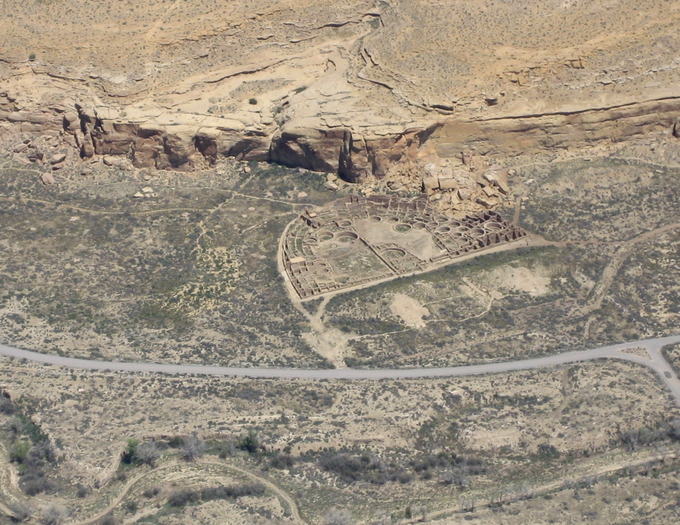
Pueblo Bonito: The impressive Pueblo Bonito was built by the Ancestral Puebloans as one of several settlements at Chaco Canyon.
Hopi Culture
The Hopi culture emerged in the Southwest in the fourteenth century. Hopi communities created ceramic jars, dough bowls, and food bowls of different sizes for daily use, as well as more elaborate ceremonial mugs, jugs, ladles, seed jars and vessels for ritual use. These were usually finished with polished surfaces and decorated with black painted designs.
Among Hopi ritual art is the kachina figure. This instructs young girls and new brides about katsinas or katsinam, the immortal beings that bring rain, control aspects of the natural world and society, and act as messengers between humans and the spirit world.

Navajo Culture
Art in the Navajo culture is traditionally gender-based. Men, seen as static in nature, create sand paintings for healing rituals. Because the pattern must be precise if the infirm person is to be cured, men were believed to be better suited for this work. Because sand paintings must be destroyed at the end of the ritual, tradition dictates that the designs not be photographed or otherwise documented. Women, on the other hand, were seen as more dynamic in nature and thus better suited for the creation of woven fabrics, such as blankets and rugs, whose patterns do not have to be exact. Unlike sand paintings, blankets and rugs are made to be long-lasting and therefore may be photographed.

Hohokam Culture
Around 200 CE, the Hohokam culture developed in Arizona as the ancestors of the Tohono O’odham and Akimel O’odham or Pima tribes. The Hohokam are credited as the first culture to master acid etching. Artisans produced jewelry from shell, stone, bone, and carved stone figures. Pottery and textile production also flourished.
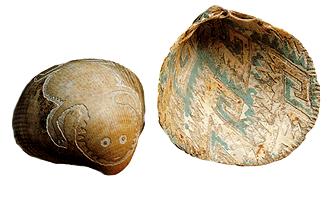
Hohokam Etched Shell: This shell was produced by the Hohokam culture of the Southwest.
Inuit Art
Inuit art is produced by the people of the Arctic, or Inuit people, who were previously known as Eskimos.
Learning Objectives
Differentiate between the Pre-Dorset, Dorset, Ipiutak, and Thule cultures of North America
Key Takeaways
Key Points
- Around 4000 BCE, nomads known as the Pre-Dorset or the Arctic Small Tool tradition (ASTt) crossed over the Bering Strait from Siberia into Alaska, the Canadian Arctic, Greenland, and Newfoundland. The Dorset culture became culturally distinct around 600 BCE.
- Walrus and narwhal ivory was historically the preferred material for carving sculptures, utensils, tools, and weapons among Pre-Dorset and Dorset artisans.
- The Dorset and Ipiutak communities that inhabited Alaska, the Canadian Arctic, Greenland, and Newfoundland were displaced by the Thule population around 1000 CE.
- The Thule carved small, delicate versions of non- utilitarian crafts and ceremonial objects that were easily transportable. They also constructed homes from bones harvested from bowhead whales and other materials.
Key Terms
- shaman: A holy person believed to mediate between the physical world and the spirit world.
- Nomad: A member of a group of people who have no fixed home and move seasonally in search of food, water, and grazing.
- Thule: The ancestors of the Canadian Inuit.
- Inuit: Any of several Aboriginal peoples of coastal Arctic Canada, Alaska, and Greenland.
Inuit art refers to artwork produced by the people of the Arctic, or Inuit people, previously known as Eskimos. Inuit culture begins with the Pre-Dorset cultures as far back as 4000 BCE and spans through the present day.
Pre-Dorset and Dorset Cultures
Around 4000 BCE, nomads known as the Pre-Dorset or the Arctic Small Tool tradition (ASTt) crossed over the Bering Strait from Siberia into Alaska, the Canadian Arctic, Greenland, and Newfoundland. Very little remains of this culture, and only a few preserved artifacts carved in ivory could be considered works of art.
The Dorset culture, which became culturally distinct around 600 BCE, produced a significant amount of figurative art using walrus ivory, bone, caribou antler, and on rare occasions, stone. Ivory from walruses and narwhals was the preferred material for carving utensils, tools, and weapons among Pre-Dorset and Dorset artisans. Subjects included birds, bears, walruses, seals, and human figures, as well as remarkably small masks. These items had a magical or religious significance, and were either worn as amulets to ward off evil spirits or used in shamanic rituals .

Carving of a polar bear: Dorset culture. Ivory. Alamek site, Iglulik, Canada.
Archaeology has been critical to knowledge of the Dorset people, who were essentially extinct by 1500 due to difficulty adapting to the Medieval Warming Period.
Ipiutak Culture
The Ipiutak culture represents a classical period of Inuit development. The culture arose between 100 and 200 BCE and collapsed around 800 CE. The artwork is extremely elaborate, incorporating geometric, animal, and anthropomorphic designs.
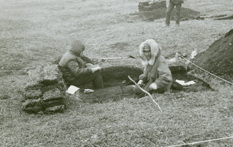
Ipiutak archaeological site at Point Hope in northwest Alaska: The Ipiutak culture arose c. 100–200 BCE and collapsed around 800 CE.
An Ipiutak archaeological site at Point Hope, Alaska, is renowned for its mortuary offerings , notably mask-like creations. One Point Hope Ipiutak mask represents a human face with a gaping mouth and blowfly larvae issuing from its nostrils, a symbol rife with shamanistic implications. The mask, which belonged to a child, contains a stylized mouth and eyebrows and a naturalistic nose, as if it had been modeled upon an actual face. Two pointed objects likely covered the eyes.

Child’s Funerary Mask: Ipiutak. Point Hope, Alaska.
Thule Culture
Around 1000 CE, the people of the Thule culture, ancestors of today’s Inuit, migrated from northern Alaska and either displaced or slaughtered the earlier Dorset inhabitants. By the thirteenth or fourteenth century, the Thule occupied an area currently inhabited by the Central Inuit, and by the fifteenth century, the Thule had fully replaced the Dorset culture. Contact with Europeans began in the 16th century and intensified in the 18th century. Compounded by the already disruptive effects of the “Little Ice Age” (1650–1850), the Thule communities broke apart, and the people became known as the Eskimos, and later as the Inuit.
Thule art had a definite Alaskan influence and included utilitarian objects such as combs, buttons, needle cases, cooking pots, ornate spears, and harpoons. The graphic decorations were purely ornamental, bearing no religious significance.
All Thule objects were made by hand from natural materials, including stone, bone, ivory, antler, and animal hides. Nomadic people carried tools necessary for daily living and could take very little else with them. Non-utilitarian objects were also carved in miniature so that they could be carried or worn, such as dance masks, amulets, fetish figures, and intricate combs and figures used to objectify their mythology and oral history.
The Classic Thule tradition (1100-1400) relied on the bowhead whale for survival since this species swims slowly and sleeps near the surface of the water. Bowhead whales served many purposes for the Thule people, including meat for food, blubber for oil (used in cooking, heating, and providing light), and bones for building structures and making tools. A Thule site in Resolute Bay , Nunavut, contains an example of a home with a whalebone frame.

Woodlands in the East
Eastern Woodland cultures are known for their production of a variety of art forms, from pottery to substantial earthen mounds for burial.
Learning Objectives
Distinguish between the early, middle, and late Woodland periods of North America.
Key Takeaways
Key Points
- The Woodland Period is divided into early, middle, and late periods , and consisted of cultures that relied mostly on hunting and gathering for subsistence.
- Pottery, stone carving and engraved shells are examples of the artwork of the shellfish-subsisting communities of the Early Woodland Period.
- The Middle Woodland Period from 200 to 500 CE is known for its jewelry and sculpture.
- The Late Woodland Period is traditionally framed as the decline for these hunter-gatherer communities, though many indigenous communities maintained similar lifestyles for several centuries.
- The agrarian Mississippian Culture emerged in the Southeast following the Late Woodland Period and is known for creating elaborate mounds, as well as ceramic innovation and work with shells and copper.
- Cahokia, a Mississippian site that extended from eastern Missouri to southern Illinois, is best known for its complex mound structure and the only copper workshop of the Woodland cultures.
Key Terms
- mound builder: Any of several Native American people who constructed large mounds for ceremonial or burial purposes.
- long-nosed god maskette: Small shield-shaped face with a squared-off forehead, circular eyes, and large nose.
- anneal: A technique that involves heating material until it glows, then slowly allowing to cool to room temperature in still air.
- Mississippian: A mound-building, agrarian Native American culture that flourished in what is now the Midwestern, Eastern, and Southeastern United States from approximately 800 to 1500 CE.
- Southeastern Ceremonial Complex: The name given to the regional stylistic similarity of artifacts, iconography, ceremonies, and mythology of the Mississippian culture that coincided with their adoption of maize agriculture and chiefdom-level complex social organization from 1200 to 1650 CE.
The Eastern Woodlands cultures inhabited the regions of North America east of the Mississippi River since at least 2500 BCE.
Contact and trade were common among the many regionally distinct Woodlands cultures. They shared the practice of burying their dead in earthen mounds, which preserved many cultural artifacts . Burial mounds in North America are part of an archetypal tradition that includes the pyramids of ancient Egypt. These structures begin on the ground and extend upward toward the sky, acting as a connection between the earthly plane and the spiritual plane. Because of this trait, the cultures are collectively known as the Mound Builders.
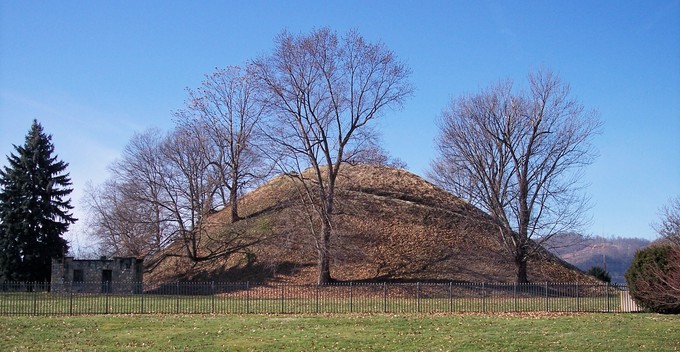
Grave Creek Mound: This mound located in modern Moundsville, West Virginia was built by the Adena culture.
Early Woodland Period
Clay for pottery was typically mixed with non-clay additives such as crushed rock or limestone . Traditional jars were conical, with rounded shoulders, slightly constricted necks, and flaring rims. Pottery was most often decorated with a variety of linear or paddle stamps that created dentate (tooth-like) impressions, wavy line impressions, checked surfaces, or fabric-impressed surfaces. Some pots were incised with geometric patterns or more rarely, pictorial imagery such as faces. Pots were coiled and paddled entirely by hand without the use of fast rotation such as a pottery wheel. Some were slipped or brushed with red ochre .

Ceramics made by the Deptford culture (800 BCE-700 CE), inhabitants of the southern East Coast and Gulf Coast, are the earliest evidence of an artistic tradition in this region. The Adena culture is another well-known example. They carved stone tablets with zoomorphic designs, created pottery, and fashioned costumes from animal hides and antlers for ceremonial rituals . Shellfish was a mainstay of their diet, and engraved shells have been found in their burial mounds.
Middle Woodland Period
The Middle Woodland Period was dominated by cultures of the Hopewell tradition (200 to 500 BCE). Their artwork encompassed a wide variety of jewelry and sculpture in stone, wood, and even human bone. Mound City, located on Ohio Highway 104, is a group of 23 earthen mounds constructed by the Hopewell culture. Each mound within the group covered the remains of a charnel house. After the Hopewell people cremated the dead, they burned the charnel house and constructed a mound over the remains. They also placed artifacts such as copper figures, mica, projectile points, shells, and pipes in the mounds.
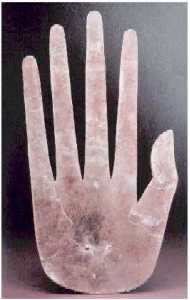
Hopewell Art: This unique Hopewell sculpture was carved from Mica between 200 BCE and 500 CE.
Late Woodland Period
The Late Woodland Period (500 to 1000 CE) saw a decline in trade and in the size of settlements, and the creation of art likewise declined. During this period, the nomadic hunter-gatherer lifestyle gradually gave way to an agrarian way of life.
The Mississippian culture flourished in what is now the Midwestern, Eastern, and Southeastern United States from approximately 800 to 1500 CE (following the Late Woodland Period). After adopting maize agriculture, the Mississippian culture became fully agrarian, as opposed to hunting and gathering supplemented by part-time agriculture practiced by preceding woodland cultures. They built larger and more complex platform mounds than those of their predecessors, and finished and developed more advanced ceramic techniques, commonly using ground mussel shell as a tempering agent. Many were involved with the Southeastern Ceremonial Complex (SECC), a pan-regional and pan-linguistic religious and trade network. Most known information about the SECC is derived from examination of the elaborate artworks left behind by its participants, including pottery, shell gorgets and cups, stone statuary, copper plates such as the Wulfing cache , and long-nosed god maskettes .

Ceramic of Underwater Panther: This Mississippian culture ceramic effigy jug was found at Rose Mound in Cross County, Arkansas, and dates from 1400-1600.
Perhaps the most famous mound-building site from this period is Cahokia, which straddles the Mississippi River between the St. Louis, Missouri area and East St. Louis, Illinois. Cahokia was the largest and most influential urban settlement of the Mississippian culture and developed advanced societies across much of what is now the central and southeastern United States, beginning more than 1000 years before European contact. Cahokia’s population at its peak in the thirteenth century was approximately 40,000.
Monks Mound is the largest structure and central focus of the city: a massive platform mound with four terraces, 10 stories tall, and the largest human-made earthen mound north of Mexico. The mound was built higher and wider over the course of several centuries through as many as ten separate construction episodes, and the terraces and apron were added.

Monks Mound: The concrete staircase is modern, but it is built along the approximate course of the original wooden stairs. Collinsville, IL.
While many Woodland cultures produced copper sculptures, Cahokia was the only Mississippian location to contain a copper workshop. The area contains the remains of three tree stumps thought to have been used to hold anvil stones. Analysis of copper found during excavations showed that it had been annealed. Artisans produced religious items, such as long-nosed god maskettes, ceremonial earrings with a symbolic shape thought to have been used in fictive kinship rituals.

By the time of European contact, the Mississippian societies were already experiencing severe social stress . With the social upsets and diseases introduced by Europeans, many of the societies collapsed and ceased to practice a Mississippian lifestyle, with the exception the Natchez people. Other tribes descended from Mississippian cultures include the Caddo, Choctaw, Muskogee Creek, Wichita, and many others.
- Curation and Revision. Provided by: Boundless.com. License: CC BY-SA: Attribution-ShareAlike
- 383px-Kachina_Doll_(Kokopol),_probably_late_19th_century,_04.297.5575.jpg. Provided by: Wikimedia Commons. Located at: commons.wikimedia.org/w/index.php?curid=34008942. License: Public Domain: No Known Copyright
- 640px-Probably_Bayeta-style_Blanket_with_Terrace_and_Stepped_Design,_1870-1880,_50.67.54.jpg. Provided by: Wikimedia Commons. Located at: commons.wikimedia.org/w/index.php?curid=34154061. License: Public Domain: No Known Copyright
- Visual arts by indigenous peoples of the Americas. Provided by: Wikipedia. Located at: en.Wikipedia.org/wiki/Visual_arts_by_indigenous_peoples_of_the_Americas. License: Public Domain: No Known Copyright
- Chaco Culture National Historical Park. Provided by: Wikipedia. Located at: en.Wikipedia.org/wiki/Chaco_Culture_National_Historical_Park. License: CC BY: Attribution
- Hopi Kachina Figures. Provided by: Wikipedia. Located at: en.Wikipedia.org/wiki/Hopi_Kachina_figures. License: CC BY-SA: Attribution-ShareAlike
- Xeriscaping. Provided by: Wikipedia. Located at: en.Wikipedia.org/wiki/Xeriscaping. License: CC BY-SA: Attribution-ShareAlike
- Visual Arts by Indigenous Peoples of the Americas. Provided by: Wikipedia. Located at: en.Wikipedia.org/wiki/Visual_arts_by_indigenous_peoples_of_the_Americas%23Southwest. License: CC BY-SA: Attribution-ShareAlike
- Hohokam. Provided by: Wikipedia. Located at: en.Wikipedia.org/wiki/Hohokam%23The_Hohokam_ceramic_tradition. License: CC BY-SA: Attribution-ShareAlike
- Pueblo. Provided by: Wikipedia. Located at: en.Wikipedia.org/wiki/Pueblo. License: CC BY-SA: Attribution-ShareAlike
- Anasazi. Provided by: Wiktionary. Located at: en.wiktionary.org/wiki/Anasazi. License: CC BY-SA: Attribution-ShareAlike
- Navajo. Provided by: Wiktionary. Located at: en.wiktionary.org/wiki/Navajo. License: CC BY-SA: Attribution-ShareAlike
- Ipiutak Site. Provided by: Wikimedia. Located at: upload.wikimedia.org/Wikipedia/commons/f/fa/Ipiutak_Site.jpg. License: CC BY-SA: Attribution-ShareAlike
- 640px-Ancient_Thule_Home.jpg. Provided by: Wikimedia Commons. Located at: commons.wikimedia.org/w/index.php?curid=19171183. License: CC BY-SA: Attribution-ShareAlike
- 640px-Ours_nageant_(Musu00e9e_du_quai_Branly)_(3034045389).jpg. Provided by: Wikimedia Commons. Located at: commons.wikimedia.org/w/index.php?curid=24672985. License: CC BY: Attribution
- 640px-Masque_funu00e9raire_(musu00e9e_du_quai_Branly)_(3035743812).jpg. Provided by: Wikimedia Commons. Located at: commons.wikimedia.org/w/index.php?curid=24672970. License: CC BY: Attribution
- Dorset Culture. Provided by: Wikipedia. Located at: en.Wikipedia.org/wiki/Dorset_culture. License: CC BY-SA: Attribution-ShareAlike
- Inuit Art. Provided by: Wikipedia. Located at: en.Wikipedia.org/wiki/Inuit_art. License: CC BY-SA: Attribution-ShareAlike
- Thule People. Provided by: Wikipedia. Located at: en.Wikipedia.org/wiki/Thule_people. License: CC BY-SA: Attribution-ShareAlike
- Inuit. Provided by: Wiktionary. Located at: en.wiktionary.org/wiki/Inuit. License: CC BY-SA: Attribution-ShareAlike
- Nomad. Provided by: Wikipedia. Located at: en.Wikipedia.org/wiki/Nomad. License: CC BY-SA: Attribution-ShareAlike
- Thule. Provided by: Wiktionary. Located at: en.wiktionary.org/wiki/Thule. License: CC BY-SA: Attribution-ShareAlike
- Mississippian culture. Provided by: Wikipedia. Located at: en.Wikipedia.org/wiki/Mississippian_culture. License: CC BY: Attribution
- Hand Hopewell mica. Provided by: Wikipedia. Located at: en.Wikipedia.org/wiki/File:Hand_Hopewell_mica.jpg. License: Public Domain: No Known Copyright
- Harrington-pottery-vessel-bussell-tn2.jpg. Provided by: Wikipedia. Located at: en.Wikipedia.org/wiki/File:Harrington-pottery-vessel-bussell-tn2.jpg. License: Public Domain: No Known Copyright
- 640px-Monks_Mound_in_July.jpeg. Provided by: Wikimedia Commons. Located at: commons.wikimedia.org/w/index.php?curid=3019271. License: CC BY-SA: Attribution-ShareAlike
- 640px-Spiro_Wulfing_and_Etowah_repousse_plates_HRoe_2012.jpg. Provided by: Wikimedia Commons. Located at: commons.wikimedia.org/w/index.php?curid=19158593%20. License: CC BY-SA: Attribution-ShareAlike
- Mound builder (people). Provided by: Wikipedia. Located at: en.Wikipedia.org/wiki/Mound_builder_(people). License: CC BY: Attribution
- Hopewell Culture National Historical Park. Provided by: Wikipedia. Located at: en.Wikipedia.org/wiki/Hopewell_Culture_National_Historical_Park. License: CC BY-SA: Attribution-ShareAlike
- Mound Builder. Provided by: Wiktionary. Located at: en.wiktionary.org/wiki/mound_builder. License: CC BY-SA: Attribution-ShareAlike
- Deptford Culture. Provided by: Wikipedia. Located at: en.Wikipedia.org/wiki/Deptford_culture. License: CC BY-SA: Attribution-ShareAlike
- Woodland Period. Provided by: Wikipedia. Located at: en.Wikipedia.org/wiki/Woodland_period. License: CC BY-SA: Attribution-ShareAlike
- Annealing (Metallurgy). Provided by: Wikipedia. Located at: en.Wikipedia.org/wiki/Annealing_(metallurgy). License: CC BY-SA: Attribution-ShareAlike
- Cahokia. Provided by: Wikipedia. Located at: en.Wikipedia.org/wiki/Cahokia. License: CC BY-SA: Attribution-ShareAlike
- Poverty Point Culture. Provided by: Wikipedia. Located at: en.Wikipedia.org/wiki/Poverty_Point_culture. License: CC BY-SA: Attribution-ShareAlike
- Visual Arts by Indigenous Peoples of the Americas. Provided by: Wikipedia. Located at: en.Wikipedia.org/wiki/Visual_arts_by_indigenous_peoples_of_the_Americas%23Eastern_Woodlands. License: CC BY-SA: Attribution-ShareAlike
- Long-Nosed God Maskette. Provided by: Wikipedia. Located at: en.Wikipedia.org/wiki/Long-nosed_god_maskette. License: CC BY-SA: Attribution-ShareAlike
- Mississippian. Provided by: Wikipedia. Located at: en.Wikipedia.org/wiki/Mississippian. License: CC BY-SA: Attribution-ShareAlike
- Southeastern Ceremonial Complex. Provided by: Wikipedia. Located at: en.Wikipedia.org/wiki/Southeastern%20Ceremonial%20Complex. License: CC BY-SA: Attribution-ShareAlike

